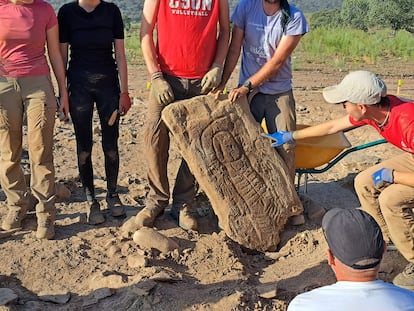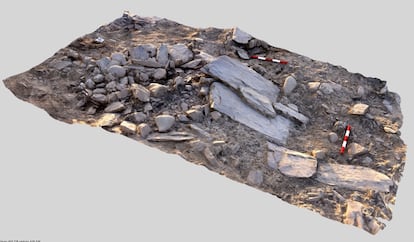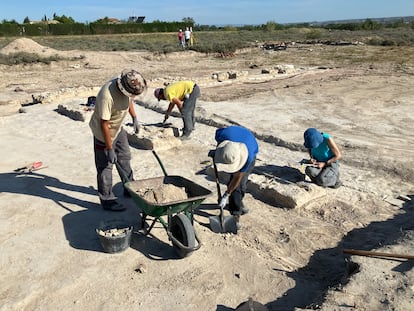A large 4,000-year-old necropolis in southern Spain reveals the true purpose of stelae
Researchers have located a ‘sensational stone slab showing a diadem’ that reverses theories about these types of archeological monuments


In 1898, the scholar Manuel Roso de Luna found a slab of stone 130 cm high by 65 cm wide in the village of Solana de Cabañas, Cáceres, in the Extremadura region of Spain, engraved with a figure surrounded by graphic representations of a brooch, a mirror, a sword, a spear, and a four-wheeled chariot. Roso de Luna understood that it was a tombstone, also known as a stela or a stele, which paid tribute to a personage from thousands of years ago. It was the first time that a stela from recent prehistory from 2,000 B.C., encompassing the Neolithic, Copper, Bronze and Iron Age, had been found on the Iberian Peninsula. Experts soon began to ask questions about its significance and have since located 300 more in Spain and Portugal.
Now, the finding of “a large necropolis with funerary monuments for ancient burial mounds, stone cists and cremation pits” in Cañaveral de León in Huelva has enabled the universities of Seville, Durham, Southampton, and Huelva to broaden their knowledge of stelae.
The discovery of a new stela just days ago that includes a diadem — the third stela to be uncovered at this site — “throws into question previous interpretations of the gender of the figures represented on the stone slabs, since those with motifs around the head of the figure had traditionally led to interpreting the figure as female, while this one clearly shows male genitalia.”
Leonardo García Sanjuán, professor of Prehistory and Archaeology at Seville University and co-director of the excavations at Las Capellanías site, together with Marta Díaz-Guardamino, David W. Wheatley and Timoteo Rivera Jiménez, states that the uncovered stelae “graphically express the fluidity and subtlety of gender concepts in the stories and narratives with which they were associated, probably related to mythical ancestors, heroes and legendary heroines.”
The Iberian Peninsula is one of the richest regions of Europe when it comes to these prehistoric stone slabs, both in terms of quantity and diversity. The stelae are generally between half a meter and several meters high, depending on the importance of the figure they pay tribute to. They are carved or painted with motifs depicting objects and scenes, but may also include epigraphic texts. The main stelae collections are in the archaeological museums of Badajoz, Seville, and Madrid’s National Museum.
The new research corroborates unequivocally for the first time in over 100 years that the stelae functioned as funerary monuments, erected in honor of people of particular social prominence. García Sanjuán explains that “despite the important catalog of these pieces, as well as their beauty and scientific value, there was a serious lack of information about the context in which they were used.”
The vast majority of Iberian stelae were stumbled upon by chance in the course of agricultural work or road building, rather than as a result of archaeological investigation. “The existing theories about their location, function, and social significance have been extremely deficient and were pending verification or demonstration,” says García Sanjuán.

According to García Sanjuán, “many of the former questions surrounding the stelae have been answered thanks to the finds at Las Capellanías.” García Sanjuán refers to the fact that in 2018, during repair work on a road, a stela of the diadem variety was found at the site. It featured a figure with the head surrounded by an ornamental object or halo and accompanied by a series of objects relating to dress and personal care, such as combs, mirrors, brooches, and belts.
After its discovery, intensive excavations began, which, in June 2022, exposed “a large necropolis” where the piece had originally come from. In one of the burial mounds, a second stela of the “warrior” variety was found with the figure engraved on it surrounded by weapons such as a shield, spear and sword, as well as other elements typical of a European Bronze Age warrior (2200 to 850 B.C.): two-wheeled carts, horses, dogs — possibly hunting dogs — mirrors, combs, razors, tweezers, brooches, weights, bows, and arrows.
The location of this second stela on a burial mound leaves no doubt as to the funerary significance of these stone slabs. But their location was also used as a marker or road sign within the prehistoric and ancient road networks.
The third stela found just several days ago features a diadem and was discovered along with cremated human bones. “This sensational find not only corroborates once again and unequivocally the association of these stelae to funerary sites but also provides more clues that can overturn many earlier theories in relation to this particular piece featuring the diadem,” says García Sanjuán. “It was assumed that they represented only females, but the one found now depicts a man, as his genitals show. On the other hand, it is also surrounded by a stash of weapons, just like the warrior stelae.”
The archaeologist Marta Díaz-Guardamino, a stela specialist, agrees that “the discovery therefore questions previous interpretations concerning the gender of the figures represented, and confirms the conceptual and semantic relationship between the different types of stelae.” In other words, they are monuments that tell complex stories, known to the people from that cultural context.
“Las Capellanías is demonstrating that many of our assumptions were wrong,” adds Díaz-Guardamino. “These investigations mark a before and after in the scientific interpretation of these beautiful prehistoric sculptures, since they offer valuable empirical information facilitating the understanding of key aspects in the social organization of the communities that inhabited the Southwest of the peninsular during the second and first millennium B.C.”
Sign up for our weekly newsletter to get more English-language news coverage from EL PAÍS USA Edition
Tu suscripción se está usando en otro dispositivo
¿Quieres añadir otro usuario a tu suscripción?
Si continúas leyendo en este dispositivo, no se podrá leer en el otro.
FlechaTu suscripción se está usando en otro dispositivo y solo puedes acceder a EL PAÍS desde un dispositivo a la vez.
Si quieres compartir tu cuenta, cambia tu suscripción a la modalidad Premium, así podrás añadir otro usuario. Cada uno accederá con su propia cuenta de email, lo que os permitirá personalizar vuestra experiencia en EL PAÍS.
¿Tienes una suscripción de empresa? Accede aquí para contratar más cuentas.
En el caso de no saber quién está usando tu cuenta, te recomendamos cambiar tu contraseña aquí.
Si decides continuar compartiendo tu cuenta, este mensaje se mostrará en tu dispositivo y en el de la otra persona que está usando tu cuenta de forma indefinida, afectando a tu experiencia de lectura. Puedes consultar aquí los términos y condiciones de la suscripción digital.
More information
Archived In
Últimas noticias
Most viewed
- Sinaloa Cartel war is taking its toll on Los Chapitos
- Oona Chaplin: ‘I told James Cameron that I was living in a treehouse and starting a permaculture project with a friend’
- Reinhard Genzel, Nobel laureate in physics: ‘One-minute videos will never give you the truth’
- Why the price of coffee has skyrocketed: from Brazilian plantations to specialty coffee houses
- Silver prices are going crazy: This is what’s fueling the rally










































